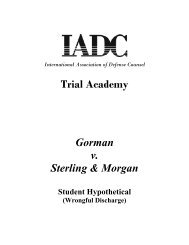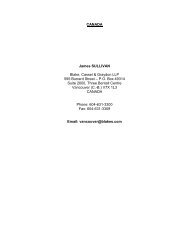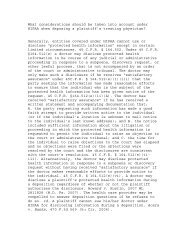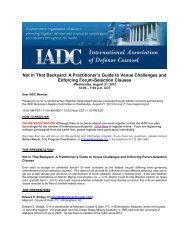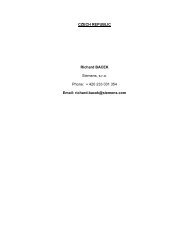Defense Counsel Journal - International Association of Defense ...
Defense Counsel Journal - International Association of Defense ...
Defense Counsel Journal - International Association of Defense ...
Create successful ePaper yourself
Turn your PDF publications into a flip-book with our unique Google optimized e-Paper software.
Page 466 DEFENSE COUNSEL JOURNAL–October 2012cost <strong>of</strong> repairing the defectiveconstruction.Ever eager to share the misery, thesued entities then turned to their generalliability insurers, claiming the defectiveconstruction was an “accident” andtherefore covered under their generalliability policies. Not since asbestoslitigation has any one coverage issuespawned so much litigation. As <strong>of</strong> thedate <strong>of</strong> this article, only seven states haveescaped addressing whether defectiveconstruction meets the definition <strong>of</strong> an“accident” and therefore constitutes acovered “occurrence” within the meaning<strong>of</strong> the I.S.O. general liability policy in usesince 1986. 2 This article explores thevarious approaches courts have taken onthe issue. It then presents other issuesthat are beginning to be addressed bycourts who have found defectiveconstruction to be an “occurrence.” Inaddition, state legislatures in at least fourstates have addressed the issue, spurredby decisions purportedly unfavorable toinsureds in those jurisdictions.I. Is Defective Construction an“Occurrence?”The broad form general liabilitypolicy widely in use since the 1960'sgrants the following coverage:We will pay those sums that theinsured becomes legally obligated topay as damages because <strong>of</strong> “bodilyinjury” or “property damage” towhich this insurance applies. ...2 See Appendix I.b. This insurance applies to “bodilyinjury” and “property damage”only if:(1) The “bodily injury” or“property damage” is causedby an “occurrence” thattakes place in the “coverageterritory”; and(2) The “bodily injury” or“property damage” occursduring the policy period. 3From this language, it is clear that inorder to trigger the coverage agreement inthe first instance, there must be “propertydamage ... caused by an ‘occurrence.’”What then is an “occurrence?” The I.S.O.policy defines an “occurrence” as “anaccident, including continuous orrepeated exposure to substantially thesame general harmful conditions.” 4 Enterthe fortuity principle—that which isaccidental is necessarily fortuitous. Thepolicy is obviously intended only to coverfortuitous events—those which areforeseeable, but not within the insured’scontrol. Arguably, if the resultant defectwas “accidental” then the loss was an“occurrence.”Other courts have reached the sameresult looking instead to policy exclusionsto justify their decisions. ComprehensiveGeneral Liability (“CGL”) policiescontain a number <strong>of</strong> exclusions, whichmight apply to bar coverage even wherethe court finds the defective construction3 Insurance Services Office, Form CG 00 0112 04, available at http://www.ramsgate.com/forms/CG0001.pdf.4 See United States Fire Ins. Co. v J.S.U.B.,Inc., 979 So.2d 871 (Fla. 2007).



